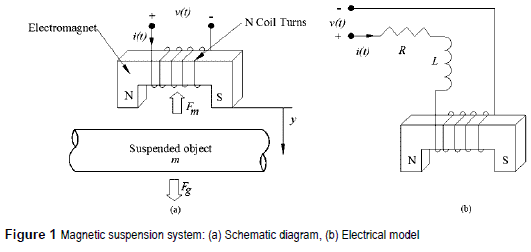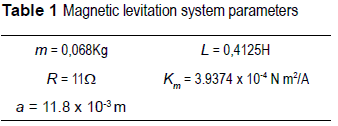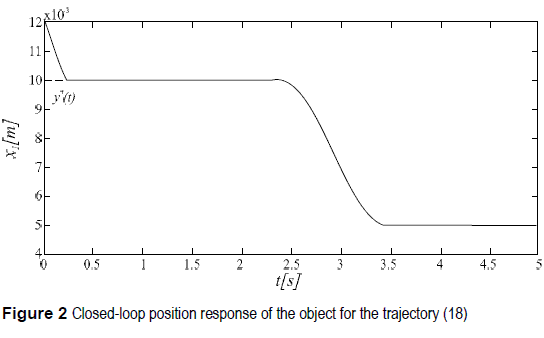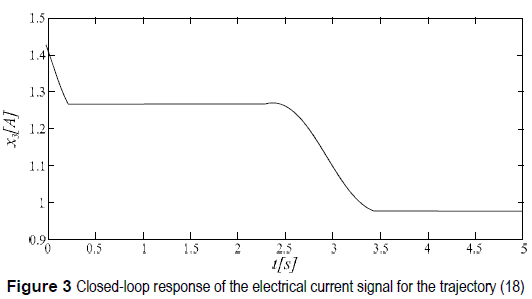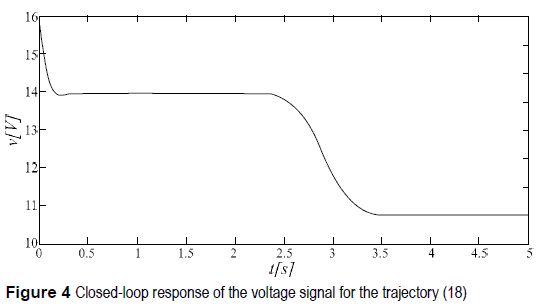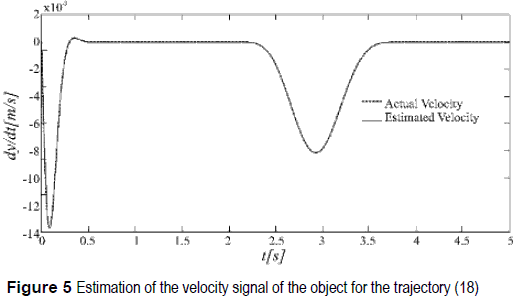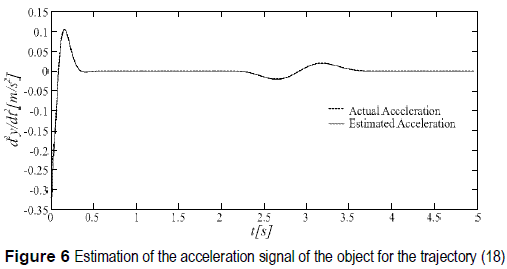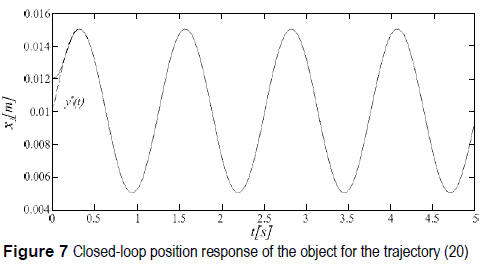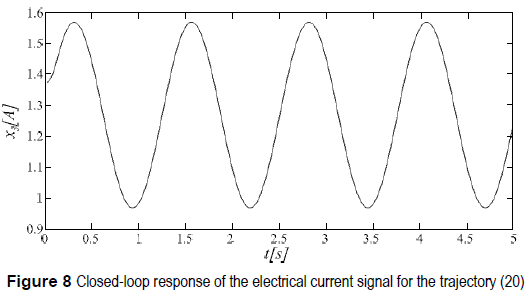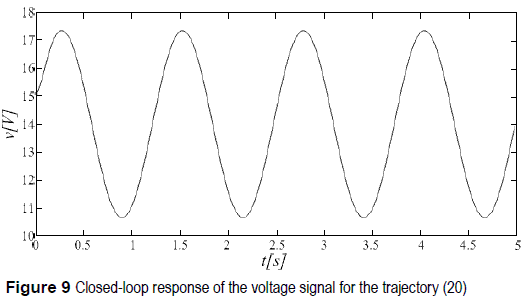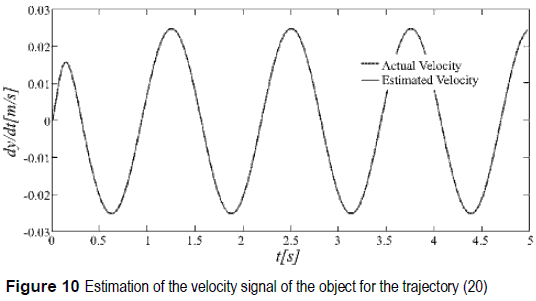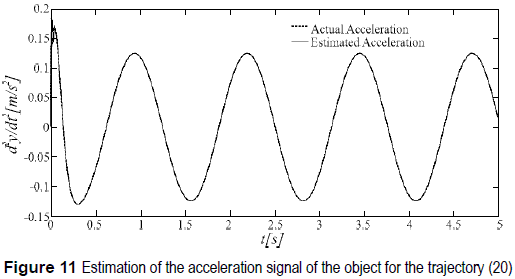Serviços Personalizados
Journal
Artigo
Indicadores
-
 Citado por SciELO
Citado por SciELO -
 Acessos
Acessos
Links relacionados
-
 Citado por Google
Citado por Google -
 Similares em
SciELO
Similares em
SciELO -
 Similares em Google
Similares em Google
Compartilhar
Revista Facultad de Ingeniería Universidad de Antioquia
versão impressa ISSN 0120-6230
Rev.fac.ing.univ. Antioquia no.66 Medellín jan./mar. 2013
ARTÍCULO ORIGINAL
Asymptotic differentiation of signals in the trajectory tracking control of a differentially flat nonlinear magnetic suspension system
Diferenciación asintótica de señales en el control de seguimiento de trayectorias de un sistema de suspensión magnética no lineal diferencialmente plano
Francisco Beltrán Carbajal1*, Antonio Favela Contreras2, Antonio Valderrábano González3, Gerardo Silva Navarro4
1Unidad Azcapotzalco. Departamento de Energía. Universidad Autónoma Metropolitana. C.P. 02200. México D.F., México.
*Autor de correspondencia: teléfono: + 52 + 555 + 318 9066, fax +52 + 555 + 318 9070, correo electrónico: fbeltran.git@gmail.com (F. Beltran)
2Departamento de Mecatrónica y Automatización. ITESM - Campus Monterrey. C.P. 64849. Monterrey, Nuevo León, México.
3Ingeniería Mecatrónica. Universidad Panamericana. Campus Guadalajara. CP 45010. Zapopan, Jalisco, México.
4Depto. de Ing. Eléctrica. Sección de Mecatrónica. CINVESTAV-IPN. C.P. 07360. México D.F., México.
(Recibido el 20 de marzo de 2012. Aceptado el 18 de enero de 2013)
Abstract
This paper deals with the problem of time-varying desired position reference traj ectory tracking tasks for an object in a differentially flat nonlinear magnetic levitation system using position measurements only. A novel scheme for signal differentiation is proposed for asymptotic estimation of velocity and acceleration. This differentiator can be utilized in many control applications of practical engineering systems where the differentiation of any signal is required. The differentiation of signals is combined with a differential flatness-based controller for asymptotic tracking of reference trajectories. Simulation results are provided to show the efficient performance of the proposed differentiator-control scheme. Two issues for reference trajectory tracking tasks are performed. The first one considers the rest-to-rest position transfer problem of the object from a nominal position to another, while the second one focuses on the sinusoidal position trajectory tracking problem.
Keywords: Magnetic levitation, differential flatness, differentiation of signals, motion planning
Resumen
En este artículo se aborda el problema de control para tareas de seguimiento de trayectorias de referencia variantes en el tiempo para la posición de un objeto en un sistema de levitación magnética no lineal diferencialmente plano, usando únicamente mediciones de posición. Se propone un esquema novedoso de diferenciación de señales para la estimación asintótica de la velocidad y aceleración. Este diferenciador de señales se puede utilizar en muchas aplicaciones de control de sistemas de ingeniería prácticos en donde se requiera la diferenciación de cualquier señal. La diferenciación de señales se combina con un controlador basado en planitud diferencial para el seguimiento asintótico de trayectorias de referencias. Se incluyen algunos resultados en simulación para mostrar el desempeño eficiente del esquema de control-diferenciador de señales propuesto. Se presentan dos casos para tareas de seguimiento de trayectorias de referencia. El primero considera el problema de transferir el objeto desde una posición de equilibrio nominal deseada a otra. El segundo aborda el seguimiento de una trayectoria sinusoidal para la posición del objeto.
Palabras clave: Levitación magnética, diferenciación de señales, planitud diferencial, planifl cación de movimiento
Introduction
Control of magnetic suspension systems has been a challenging research topic over the years with a growing application trend in efficient innovative mechatronic product design. Some practical applications of magnetic levitation can be found in high-speed passenger trains, magnetic bearings, vibration isolation systems, turbo machinery, machine tools and electric drives [1, 2].
Actually, nonlinear and linear control schemes based on sliding modes, feedback linearization, backstepping, classical control, neural networks, optimal control, adaptive control, and other control design methodologies have been applied to magnetic levitation systems [2 - 15]. However, the controller design problem is mainly based on lineal simplified mathematical models which are only valid around nominal operation points. In addition, state feedback-based nonlinear controllers require measurements of position, velocity and electric current, increasing the control implementation costs. In order to reduce the number of sensors, model based-asymptotic state observers have also been proposed to estimate the state vector for specific nonlinear dynamic systems [16]. The design problem of this kind of observers is the unstable nonlinear system dynamics. Another common alternative in practice to differentiate signals with respect to time is based on real-time numerical computations from samplings of the available output signals. Nevertheless, it is widely known this approach deteriorates the efficiency and robustness of the controller significantly. Additionally, most above control proposals have been mainly focused on the suspended object regulation problem about a nominal operation. Therefore, the controlled motion planning problem using only an output sensor still offers huge opportunities for design of energy-saving control technology, reducing peaks of electrical currents and voltages and as a consequence the reduction of manufacturing and operation costs.
On the other hand, many dynamical systems exhibit a structural property called differential flatness. This property is equivalent to the existence of a set of independent outputs, called flat outputs and equal in number to the control inputs, which completely parameterizes every state variable and control input [17]. By means of differential flatness the analysis and design of a controller is greatly simplified, including tracking of reference trajectories in accordance with the desired motion planning to system.
In this paper the control problem for time-varying desired position reference trajectory tracking tasks for an object in a nonlinear magnetic levitation system using only position measurements is the focus of interest. The differential flatness property exhibited by this mechatronic system is employed to design the proposed output feedback control scheme. This structural property that presents the controllable dynamic systems has been previously addressed by the authors in the context of active vehicle suspension control in [18]. Since this controller needs information of the velocity and acceleration of the suspended object, a novel scheme of differentiation of signals is proposed for asymptotic estimation of those unavailable signals from measurements of the output variable. The main attribute of the presented signal differentiation approach is that it does not need a mathematical model of the nonlinear system for its design and implementation. Hence, the differentiator of signals can be applied to many control applications of practical engineering systems where time derivatives of some signals are required, and possibly an accurate mathematical model of the system is not available.
The design process of the differentiation scheme considers that the output signal can be locally approximated by a family of Taylor polynomials. Then, this polynomial model of the signal is used to design a Luenberger observer to estimate high order time derivatives ofthe output signal. Finally, some simulation results are provided to show the effective and efficient performance of the proposed signals differentiator-control scheme. Two issues for reference trajectory tracking tasks are performed. The first one considers the rest- to-rest position transfer problem of the object from a nominal position to another. The second case focuses on the sinusoidal position trajectory tracking problem.
Magnetic suspension system
Consider the schematic diagram of a magnetic suspension system shown in figure 1. Here, an electromagnet is used to suspend a magnetic object of mass m in the air by applying a control electromagnetic force Fm. The electromagnet is modeling as a resistance in series with an inductance given by [16]

where L1 is the inductance without the object, L0 is the incremental inductance with the suspended object, y is the vertical displacement of the object measured from electromagnetic core flat face, and y* is the desired reference position. One can then get the differential equation governing the electric current i by using Kirchoff's voltage law:

Moreover, one can simplify the analysis by assuming that when the system is properly designed, the object will remain close to its nominal operation trajectory, i.e, y =y*. Then, the inductance is simplified to L=L1+L0 [2, 14, 15], Hence, equation (2) is simplified to

The control force Fm generated by the electromagnet is given by [14]

where α is a constant, which is commonly determined by experimentation to prevent that the force is infinite when y = 0 and Km is the electromagnetic force constant given by

where g is the gravitational constant and I* is the necessary current to maintain the object at the desired position. Then, the total external force experienced by the suspended object is given by

where Fg is the force due to gravity. Then, by applying Newton's second law to the object, the equation of motion results in

Defining the state variables as x1= y, x2 =  , and x3 = i, one obtains from (3) and (7) the state space description
, and x3 = i, one obtains from (3) and (7) the state space description
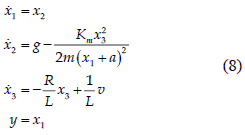
It is easy to verify that the system (8) is completely controllable and observable, but unstable in open loop. Thus, in what follows the differential flatness property exhibited by the system will be used to design a controller to perform closed-loop trajectory tracking tasks in vertical direction, including the suspension of the object around specified operation points.
Differential flatness-based control
Because the magnetic suspension system (8) is completely controllable from v then, it is differentially flat [17], with flat output given by the object position y = x1. Then, all the system variables can be differentially parameterized in terms of the flat output y and a finite number of its time derivatives as follows
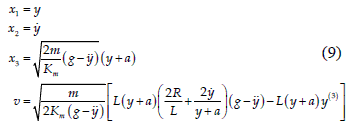
From (9), the flat output y satisfies the input- output differential equation

where
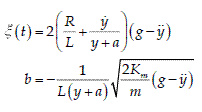
One then obtains the following differential flatness-based controller to asymptotically track some desired reference trajectory y*(t):

with

The use of this controller yields the closed-loop dynamics of the tracking error e = y -y*(t):

Therefore, selecting the design parameters αi, i = 0, ... 3, such that the associated characteristic polynomial for (14) be Hurwitz, one can guarantee that the error dynamics be globally asymptotically stable.
Since the controller (13) requires information of the velocity and acceleration of the suspended object, an asymptotic differentiation scheme of signals is presented in the next section, which does not require any mathematical model of the magnetic suspension system for its design and implementation. Therefore, the proposed signal differentiation approach can be applied and extended to other engineering applications where time derivatives of signals are needed, for instance, control system implementation, identification, supervision and detection of faults.
Differentiation of signals
During the design process of our differentiation scheme of signals, it is assumed that the position signal of the object y(t) can be locally approximated by a family of Taylor polynomials of (r-1)-th degree:

where all the coefficients  are considered completely unknown.
are considered completely unknown.
The output signal could then be locally described by the following mathematical model:
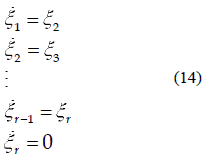
where 
A Luenberger observer for the sy stem (14) is then synthesized as
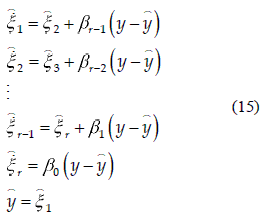
The dynamical system describing the state estimation error is readily obtained by subtracting (15) from (14). One then obtains, with  , i=1, 2, ...,r, that
, i=1, 2, ...,r, that
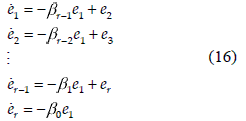
From this expression, the characteristic polynomial of the observation error dynamics is given by

which is completely independent of any coefficients pi, i = 0,..., r - 1, of the Taylor polynomial expansion of y(t). This means that, the high-gain observer continuously self-updates. Therefore, as time goes on, the position signal is approximated in the form of a (r-1)-th degree time polynomial.
Clearly, the coefficients of the characteristic polynomial (17) can be adjusted sufficiently far from the imaginary axis in the left half of the complex plane, faster than the system dynamics, so that output estimation error exponentially asymptotically converges to zero.
Simulation results
Some numerical simulations were performed on a magnetic suspension system characterized by the set of system parameters given in table 1 [15, 19].
The design parameters of the controller (11) were selected to have the following third order characteristic polynomial for the closed-loop tracking error dynamics (12):
pc(s) = (s + p1)(s2+2ζωns+ ωn2)
with p1= ωn = 20 rad/s and ζ= 0.7071.
The characteristic polynomial for the fifth order observation error dynamics was set to be of the following form:
pc(s) = (s + p0)(s2 +2ζ0ω0s +ω02)4
with pc=ω0 = 250 rad/s y ζ0 = 1.
Figures 2-4 depict the efficient performance of the differential flatness-based output feedback controller (11) using the differentiator of signals (15) for its implementation. The rest-to-rest stabilization of the object about equilibrium positions and the robust tracking of a desired reference trajectory are accomplished. The smooth transference between two nominal operation points for the suspended object can be observed, avoiding peaks of electrical current and voltage, which is a common problem in control laws that do not consider the motion planning into their design and implementation. In this performance test, the position reference trajectory for the object position y=x1 was specified as

where  1= 0.01m,
1= 0.01m,  2 = 0.005m, T1 = 2s, T2 = 4s, y ψ(t, T1, T2) is a Bezier polynomial, such that ψ(T1, T1, T2) = 0 and ψ(T2, T1, T2) = 1, described by
2 = 0.005m, T1 = 2s, T2 = 4s, y ψ(t, T1, T2) is a Bezier polynomial, such that ψ(T1, T1, T2) = 0 and ψ(T2, T1, T2) = 1, described by

With r1=252, r2=1050, r3=1800, r4=1575, r5=700, r6=126.
Figures 5-6 describe the efficient performance of the differentiation scheme of signals to get online estimates of the velocity and acceleration of the suspended object. One can observe the fast estimation of those unavailable signals from sensors, which does feasibility the implementation of the output feedback controller (11) specified to perform the motion planning task (18), using position measurements only.
On the other hand, figures 7-9 illustrate the excellent performance of the proposed signal differentiation-control scheme for the asymptotic tracking tasks of a sinusoidal reference trajectory given by

where  = 0.01m, A = 0.005m and ω = 5rad/s.
= 0.01m, A = 0.005m and ω = 5rad/s.
In figures 10-11 the effectiveness of the signal differentiation scheme (15) is verified. The fast estimation of the velocity and acceleration of the suspended object is once again achieved. Therefore, one can conclude that the proposed signal differentiator represents an alternative solution to the practical implementation problem of nonlinear control schemes for reference trajectory tracking for nonlinear magnetic suspension systems. Moreover, since this differentiator of signals does not require any mathematical model of the system for its implementation, it can be applied and extended for nonlinear and linear control implementation for any engineering system where time derivatives of output signals are needed. Note that an important practical limitation of most the current nonlinear control schemes based on motion planning for high order nonlinear dynamic systems is that the state vector or time derivatives of the output signals must be available for their implementation. Thus, model-based nonlinear state observers have been proposed to control specific nonlinear dynamic systems. Unfortunately, many times the observer design is quite difficult or impossible to be performed due to the nonlinear nature of the system.
Conclusions
In this article we have proposed a differential flatness-based controller for time-varying desired position reference trajectory tracking tasks for an object in a nonlinear magnetic levitation system. In addition, an innovative differentiation scheme of position signals based on Luenberger observers and Taylor polynomials has been proposed for on-line effective estimation of the velocity and acceleration of the suspended object. The main advantage of our differentiator is that it does not need a mathematical model of the system, allowing thus its use in many practical engineering applications where time derivatives of signals are required and a mathematical model is not available. The simulation results show a high efficiency, effectiveness and robust performance of our proposed differentiator-control scheme for two motion planning tasks. The first one considers the rest-to-rest position transfer problem of the object from a nominal position to another, while the second one focuses on the sinusoidal position trajectory tracking problem.
References
1. G. Schweitzer, E. Maslen. "Magnetic Bearings. Theory, Design and Application to Rotating Machinery". Ed. Springer. Germany. 2010. pp. 1-26. [ Links ]
2. A. Hajjaji, M. Ouladsine. "Modeling and Nonlinear Control of Magnetic Levitation Systems." IEEE Transactions on Industrial Electronics. Vol. 48. 2001. pp. 831-838. [ Links ]
3. F. Lin, L. Teng, P. Shieh. "Intelligent Adaptive Backstepping Control System for Magnetic Levitation Apparatus." IEEE Transactions on Magnetics. Vol. 43. 2007. pp. 2009-2018. [ Links ]
4. D. Cho, Y. Kato, D. Spilman. "Sliding mode and classical control magnetic lévitations systems." IEEE Control Systems Magazine. Vol. 13. 1993. pp. 42-48. [ Links ]
5. M. Lairi, G. Bloch. "Neural control of Maglev system", Proceedings of MCEA'98. Marrakech. Morocco. 1998. pp. 472-475. [ Links ]
6. J. Slotine. "Applied Nonlinear Control". NJ: Prentice- Hall. Englewood Cliffs. 1991. pp. 1-405. [ Links ]
7. F. Zhao, S. Loh, J. May. "Phase-space nonlinear control toolbox: The maglev experience". Proceedings of Hybrid Systems Workshop. Notre Dame. USA. 1997. pp. 1- 9. [ Links ]
8. C. Bonivento, L. Gentili, L. Marconi. "Balanced Robust Regulation of a Magnetic Levitation System". IEEE Transactions on Control Systems Technology. Vol. 13.2005. pp. 1036-1044. [ Links ]
9. L. Gentili, L. Marconi. "Robust nonlinear disturbance suppression of a magnetic levitation system." Automatica. Vol. 39. 2003. pp. 735-742. [ Links ]
10. J. Yang, Y. Lee, O. Kwon. "Development of Magnetic Force Modeling Equipment for Magnetic Levitation System". Proceedings of 2010 International Conference on Control Automation and Systems (ICCAS). Gyeonggi-do. Korea. 2010. pp. 29-33. [ Links ]
11. Z. Yang, K. Kunitoshi, S. Kanae, K. Wada. "Adaptive Robust Output-Feedback Control of a Magnetic Levitation System by K-Filter Approach." IEEE Trans. on Industrial Electronics. Vol. 55. 2008. pp. 390-399. [ Links ]
12. C. Lin, M. Lin, C. Chen. "SoPC-Based Adaptive PID Control System Design for Magnetic Levitation System." IEEE Systems Journal. Vol. 5. 2011. pp. 278287. [ Links ]
13. M. Feemster, Y. Fang, D. Dawson. "Disturbance Rejection for a Magnetic Levitation System." IEEE/ ASME Trans. on mechatronics. Vol. 11. 2006. pp. 709717. [ Links ]
14. F. Suryawan, J. Dona, M. Seron. "Methods for trajectory generation in a magnetic-levitation system under constraints". Proceedings of 18th Mediterranean Conference on Control & Automation. Marrakech. Morocco. 2010. pp. 945-950. [ Links ]
15. A. Yetendje, M. Seron, J. De Dona, J. Martinez. "Sensor fault-tolerant control of a magnetic levitation system." International Journal of Robust and Nonlinear Control. Vol. 20. 2010. pp. 2108-2121. [ Links ]
16. H. Khalil. Nonlinear Systems. Prentice Hall. 3rd. Ed. New Jersey. USA. 2002. pp. 1-32. [ Links ]
17. M. Flies, J. Le vine, P. Martin, P. Rouchon. "Flatness and detect of nonlinear systems: Introductory theory and examples." International Journal of control. Vol. 61. 1993. pp. 1327-1361. [ Links ]
18. E. Chavez, F. Beltran, A. Valderrabano, A. Favela. "Active Vibration Control of Vehicle Suspension Systems Using Sliding Modes, Differential Flatness and Generalized Proportional-Integral Control." Rev. Fac. Ing. Univ. Antioquia. No. 61. 2011. pp. 104-113. [ Links ]
19. Quanser Inc. Magnetic Levitation Plant Manual. Markham. Ontario. Canada. 2006. http://www.quanser.com/. pp. 1-12. [ Links ]













